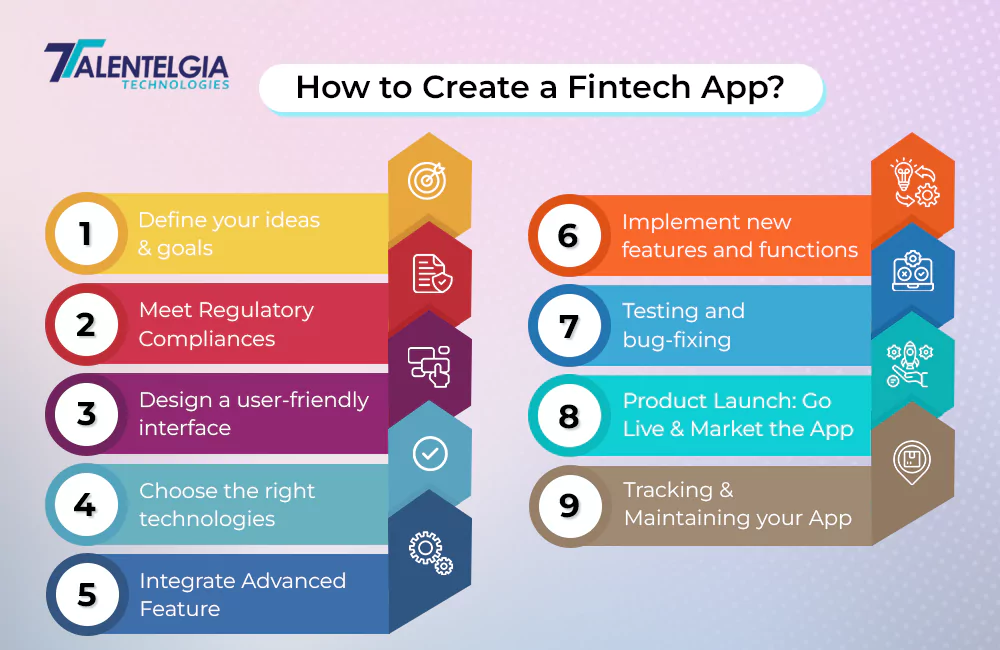Fintech also known as financial technology refers to the use of technology to deliver financial services such as banking, investing, payments, and insurance.
It is transforming traditional financial processes by making them more efficient, accessible, and innovative.
Fintech applications give businesses an advantage by facilitating purchases and sales like never before, making everything faster, easier, and safer. Therefore, the way we save, spend, and invest is transforming. However, before hiring fintech app development services, understanding its intricacies is important. In this blog post, we will look at the app development process for fintech apps. So if you are also wondering how to create a fintech app, read below.

Step 1: Define your Ideas & Goals
First, clarify the goals of your fintech app, so you will have a reference point for development. The initial step is identifying the idea of your app and refining it. Will you target and solve a specific problem for the users?
Conduct an in-depth market investigation aimed at identifying the needs, wishes, and habits of your potential customers. Define your target audience, their ages, income range, and where they reside. After that, you can adjust the app to be in line with the features and functions that suit them. Building a user persona helps you identify a customer’s needs, pain points, and desires, helping in design and development decisions in the initial stages.
Step 2: Meet Regulatory Compliances
Ensuring your fintech app complies with all regulations is critical to its success. Before moving into the development phase, take some time to understand the rules and regulations regarding financial practices in your business plan. To effectively navigate the difficult compliance journey, seek guidance from legal experts who specialize in fintech regulations.
Joint implementation of decisions early in the development process is important; it saves time and makes your application compatible from the start.
First, protect the user’s data by taking good security measures and using controls to prevent money laundering and other financial crimes. Customer protection should be a priority by providing transparency and support to users. Stay informed about changing regulations so you can adjust your strategy accordingly. By following these steps, you can create a fintech application that is both compliant with the legislation and builds trust and confidence in users, thus clearly encouraging trust for a long time.

Step 3: Design a User-friendly Interface
User interface design that is easy to use and understand is the goal of allowing a pleasant experience. Start the process by creating wireframes and prototypes to draw out the layout and flow of the app and conduct user testing to get feedback on the user experience.
Focus on simplicity and clarity in your design; start by establishing clear navigation options while terrifying your audience with calm. Ensure that you use colors, fonts, and visuals that will make the interface look consistent, unified, and artistic. Engage the real user in the usability testing to obtain feedback, then continue iterating on your designs until they meet the real users’ needs and exceed their expectations.
Step 4: Choose the Right Technologies for Backend Development
When contemplating how to create a fintech app, security is an important aspect. Top-notch fintech app development is a must-have as users often input confidential information about their finances. Develop rich backend systems that are solid and that provide the highest level of data security and privacy.
Encryption protocols like SSL/TLS# can be established for data transfer to guarantee security between the app and server.
Design in such a way that secure authentication mechanisms (e.g., multi-factor authentication) would be used to prevent unauthorized access to the accounts of the users. Frequently conduct updates and patching of the backend system to detect any open holes that might be present, and also try to stay ahead of any newly emerging threats.
Technologies for Fintech App Development
| Category | Web Apps | Android Apps | iOS Apps |
| Backend | Java (Spring Boot, etc.) Python (Django, Flask) Node.js (Express.js) PHP (Laravel) | Java (Kotlin) Kotlin | Swift Objective-C (less common) |
| Frontend | HTML5 CSS3 JavaScript (React, Angular, Vue.js) | Kotlin (with XML layouts) | Swift (with SwiftUI or UIKit) |
| Database | MySQL PostgreSQL MongoDB Oracle | Room SQLite Cloud Firestore | Core Data Realm |
| Security | SSL/TLS Encryption – API authentication (OAuth, JWT) | Android security framework Fingerprint authentication | Secure Enclave App Transport Security (ATS) |
| Mobile Development Tools | Cross-platform frameworks (React Native, Flutter) | Android Studio | Xcode |
| Cloud Platforms | Amazon Web Services (AWS) Microsoft Azure Google Cloud Platform (GCP) | Firebase AWS Mobile Hub Azure App Service | AWS Amplify Firebase Azure App Service |
| Payments | Stripe Braintree PayPal | In-app billing Stripe Braintree | In-app purchase Stripe Braintree |
The expert team at Talentelgia Technologies has extensive experience in offering mobile and web app development services. Our team indulged in extensive research to help you find the best technologies for your app. Although the right technology will depend on your requirements and your app model, here is what our experts found on the leading platforms like Quora, and Reddit.
We researched whether a fintech app can be built using no-code platforms like Bubble.io or similar tools, given the complexities and security requirements involved in fintech.
Several users express their opinions and suggestions. Some argue that no-code solutions may require double the effort and could lead to less flexible end products, especially for heavily regulated industries like fintech. Others recommended going for React Native app development or Flutter app development services for better flexibility and security.
It’s highlighted that security concerns are paramount in fintech, and having the right knowledge and attitude is crucial. Additionally, building a banking product with no code alone is deemed near impossible, and working with banking-as-a-service companies via API is suggested. Finding a technical co-founder is also encouraged while building demand and understanding user needs.
Step 6: Testing and Bug-fixing

Testing helps in detecting and fixing any bugs, glitches, or performance problems before the final launch.
Conduct extensive testing across all kinds of devices, operating systems, and networks to ensure that they are consistent and, by all means, reliable. Use AI testing tools extensively to speed up the process and show possible areas that should be improved.
Also, involve interested beta users. Modify your app based on this feedback, keeping the design up-to-date and developing the best product in terms of quality and usability.
Step 7: Product Launch: Go Live and Market the App

Right after the launch of your fintech app, it is very important to formulate a good marketing strategy that will enable the users to realize the magnitude of attraction the app has and motivate them to sign up. Use social media, email marketing, content marketing, and application store optimization to reach a targeted audience.
Highlight the features and benefits of your app to get a competitive edge. Track the user feedback and analytics at the launch and utilize them to determine the level of satisfaction and what chances for further optimization are there. Performing continuous construction on your marketing strategy to achieve the maximum user base and retention to stay long in the market and steer the competition.
Step 8: Tracking & Maintaining your App
In the ever-changing world of fintech, it’s important to pay attention to how your apps work. Start by using free tools like Google Analytics 4 and Microsoft Clarity to understand how people use your app.
If you want more detailed information, you can try paid options such as AppsFlyer, Adjust, or Mixpanel. Pay attention to important issues such as the number of users of your app.
Be sure to fix issues and listen to user feedback to make your app better. Also, remember to follow the rules and keep people’s information safe. Regular maintenance is also important, so make sure to update, fix bugs, and improve your app regularly to keep it running smoothly. By doing these things, you can ensure that your fintech app stays in good shape and that people continue to have fun using it.
Conclusion
Finding answers to how to create a fintech app is often a complicated and demanding process. However strategic planning and execution can make this easier. Following the steps described above, you can build a fintech app that not only provides services to your target audience but also offers value, guaranteed security, and a convenient solution.
In summary, building a FinTech application means that you have to have a strategic plan, technical skills, and a user-driven approach. The 8 steps outlined above present you with a way to build a fintech app that fulfills all the requirements of the target audience and enables your business to rise out of the financial technology market competition, which leads to substantial engagement and profitability.
FAQs
Why should I develop a fintech app?
The fintech app gives businesses a chance to use innovation, to meet the needs of their user base. It helps you to make the processes easier by offering a better user experience, and making the most of new opportunities while the needs of the consumers in the digital age are visualized.
How can I monetize my fintech app?
You have many options to monetize your fintech apps. You can earn through subscription models, transaction fees, in-app purchases, and partnerships with banks and third-party service providers, based on your app type and its target audience.
What are the latest trends in fintech app development?
The recent advances in fintech app development are the expansion of DEFI, AI and ML incorporation for hyper-personalized financial services, blockchain technology for safe and reliable transactions, and, beyond that, mandatory cybersecurity measures to maintain total data privacy.


 Healthcare App Development Services
Healthcare App Development Services
 Real Estate Web Development Services
Real Estate Web Development Services
 E-Commerce App Development Services
E-Commerce App Development Services E-Commerce Web Development Services
E-Commerce Web Development Services Blockchain E-commerce Development Company
Blockchain E-commerce Development Company
 Fintech App Development Services
Fintech App Development Services Fintech Web Development
Fintech Web Development Blockchain Fintech Development Company
Blockchain Fintech Development Company
 E-Learning App Development Services
E-Learning App Development Services
 Restaurant App Development Company
Restaurant App Development Company
 Mobile Game Development Company
Mobile Game Development Company
 Travel App Development Company
Travel App Development Company
 Automotive Web Design
Automotive Web Design
 AI Traffic Management System
AI Traffic Management System
 AI Inventory Management Software
AI Inventory Management Software
 AI Software Development
AI Software Development  AI Development Company
AI Development Company  AI App Development Services
AI App Development Services  ChatGPT integration services
ChatGPT integration services  AI Integration Services
AI Integration Services  Generative AI Development Services
Generative AI Development Services  Natural Language Processing Company
Natural Language Processing Company Machine Learning Development
Machine Learning Development  Machine learning consulting services
Machine learning consulting services  Blockchain Development
Blockchain Development  Blockchain Software Development
Blockchain Software Development  Smart Contract Development Company
Smart Contract Development Company  NFT Marketplace Development Services
NFT Marketplace Development Services  Asset Tokenization Company
Asset Tokenization Company DeFi Wallet Development Company
DeFi Wallet Development Company Mobile App Development
Mobile App Development  IOS App Development
IOS App Development  Android App Development
Android App Development  Cross-Platform App Development
Cross-Platform App Development  Augmented Reality (AR) App Development
Augmented Reality (AR) App Development  Virtual Reality (VR) App Development
Virtual Reality (VR) App Development  Web App Development
Web App Development  SaaS App Development
SaaS App Development Flutter
Flutter  React Native
React Native  Swift (IOS)
Swift (IOS)  Kotlin (Android)
Kotlin (Android)  Mean Stack Development
Mean Stack Development  AngularJS Development
AngularJS Development  MongoDB Development
MongoDB Development  Nodejs Development
Nodejs Development  Database Development
Database Development Ruby on Rails Development
Ruby on Rails Development Expressjs Development
Expressjs Development  Full Stack Development
Full Stack Development  Web Development Services
Web Development Services  Laravel Development
Laravel Development  LAMP Development
LAMP Development  Custom PHP Development
Custom PHP Development  .Net Development
.Net Development  User Experience Design Services
User Experience Design Services  User Interface Design Services
User Interface Design Services  Automated Testing
Automated Testing  Manual Testing
Manual Testing  Digital Marketing Services
Digital Marketing Services 
 Ride-Sharing And Taxi Services
Ride-Sharing And Taxi Services Food Delivery Services
Food Delivery Services Grocery Delivery Services
Grocery Delivery Services Transportation And Logistics
Transportation And Logistics Car Wash App
Car Wash App Home Services App
Home Services App ERP Development Services
ERP Development Services CMS Development Services
CMS Development Services LMS Development
LMS Development CRM Development
CRM Development DevOps Development Services
DevOps Development Services AI Business Solutions
AI Business Solutions AI Cloud Solutions
AI Cloud Solutions AI Chatbot Development
AI Chatbot Development API Development
API Development Blockchain Product Development
Blockchain Product Development Cryptocurrency Wallet Development
Cryptocurrency Wallet Development About Talentelgia
About Talentelgia  Our Team
Our Team  Our Culture
Our Culture 
 Healthcare App Development Services
Healthcare App Development Services Real Estate Web Development Services
Real Estate Web Development Services E-Commerce App Development Services
E-Commerce App Development Services E-Commerce Web Development Services
E-Commerce Web Development Services Blockchain E-commerce
Development Company
Blockchain E-commerce
Development Company Fintech App Development Services
Fintech App Development Services Finance Web Development
Finance Web Development Blockchain Fintech
Development Company
Blockchain Fintech
Development Company E-Learning App Development Services
E-Learning App Development Services Restaurant App Development Company
Restaurant App Development Company Mobile Game Development Company
Mobile Game Development Company Travel App Development Company
Travel App Development Company Automotive Web Design
Automotive Web Design AI Traffic Management System
AI Traffic Management System AI Inventory Management Software
AI Inventory Management Software AI Software Development
AI Software Development AI Development Company
AI Development Company ChatGPT integration services
ChatGPT integration services AI Integration Services
AI Integration Services Machine Learning Development
Machine Learning Development Machine learning consulting services
Machine learning consulting services Blockchain Development
Blockchain Development Blockchain Software Development
Blockchain Software Development Smart contract development company
Smart contract development company NFT marketplace development services
NFT marketplace development services IOS App Development
IOS App Development Android App Development
Android App Development Cross-Platform App Development
Cross-Platform App Development Augmented Reality (AR) App
Development
Augmented Reality (AR) App
Development Virtual Reality (VR) App Development
Virtual Reality (VR) App Development Web App Development
Web App Development Flutter
Flutter React
Native
React
Native Swift
(IOS)
Swift
(IOS) Kotlin (Android)
Kotlin (Android) MEAN Stack Development
MEAN Stack Development AngularJS Development
AngularJS Development MongoDB Development
MongoDB Development Nodejs Development
Nodejs Development Database development services
Database development services Ruby on Rails Development services
Ruby on Rails Development services Expressjs Development
Expressjs Development Full Stack Development
Full Stack Development Web Development Services
Web Development Services Laravel Development
Laravel Development LAMP
Development
LAMP
Development Custom PHP Development
Custom PHP Development User Experience Design Services
User Experience Design Services User Interface Design Services
User Interface Design Services Automated Testing
Automated Testing Manual
Testing
Manual
Testing About Talentelgia
About Talentelgia Our Team
Our Team Our Culture
Our Culture

















 Write us on:
Write us on:  Business queries:
Business queries:  HR:
HR: 




